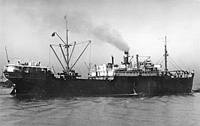EFC Design 1027 (Oscar Daniels type): Notes & Illustrations

Click here for larger and more complete plans from the 1920 USSB ship register: Sheet 1, Sheet 2. (Download for full size)
Click on the photographs below to prompt larger views of the same images.
|
Notes: In 1900 Ernest Kreher organized the Tampa Foundry and Machine Company, which in 1917 became the Tampa Shipbuilding Company. This firm built two 3500-ton merchant ships for the British Government, War Wonder and War Work, which were requisitioned by the USSB in 1917 as Everglades and Lithopolis. However in early 1917 Kreher, a German immigrant, aroused suspicion as to his loyalty for publicly refusing to subscribe to the Liberty Loan and ultimately stepped down as president of Tampa Shipbuilding while remaining general manager. In the fall of 1917 the company properties were leased for six years to the Oscar Daniels Company (a subsidiary of a Chicago engineering firm), which on 30 October 1917 concluded a contract with the EFC to build ten steel cargo ships. Their design, a 9500-ton shelter deck ship with two decks (shelter and upper), one 'tween deck, and three islands of regular (not prefabricated) construction, was one of four cargo ship designs by shipbuilders that were reviewed and approved in late 1917 by Theodore E. Ferris, the EFC's naval architect and consulting engineer. See the page on EFC Design 1037 for more on two-decked shelter deck ships. The Design 1027 ships were also built on the Isherwood system of longitudinal framing instead of the transverse system. In 1923, Oscar Daniels returned operation of the now idle shipyard to Ernest Kreher, who had been restored as president. (Special source: Andrew T. Huse, From Saloons to Steak Houses: A History of Tampa, University Press of Florida, 2020.) The USSB Diesel Program, Phase I (1924-28): A 6 June 1924 amendment to the Merchant Marine Act of 1920 authorized the Shipping Board to install internal combustion (Diesel) engines in vessels of the Government, both to find an acceptable type for use in the American merchant marine and to create competition in the development of the various types and promote the manufacture of such engines in the U.S. By a Shipping Board resolution of 2 December 1924 contracts were awarded for nine single-acting engines (4 by Busch-Sulzer, 3 by McIntosh & Seymour, and 2 by Pacific Diesel Engine) and five double acting engines (1 by Hooven, Owens, Rentschler; 1 by McIntosh & Seymour, 1 by New London Ship & Engine, and 2 by Worthington Pump & Machinery). On 7 April 1925 the Board selected 14 steel vessels to be converted from reciprocating steam engines to internal combustion engines: eight of Design 1027 built by Oscar Daniels and six of Design 1013, of which two were cancelled. It was hoped that the program would eventually result in the conversion of about 50 cargo ships and tankers. 1027. Six of the eight Oscar Daniels ships were ordered from Newport News SB&DD, Tampa and Unicoi with 2900 bhp 2 cycle 4 cylinder Worthington diesels on 21 April 1926, Sawokla on 9 July 1926, City of Rayville on 18 August 1926, City of Dalhart on 31 December 1926, and Yomachichi on 12 April 1927, all four with 3000 bhp 2 cycle 6 cylinder Busch-Sulzer diesel diesels. Seminole, which received the Hooven, Owens, Rentschler diesel, was ordered from Tietjen & Lang on 15 April 1927 and Wilscox was converted by Bethlehem with a 3300 bhp 2 cycle 4 cylinder New London diesel and placed in commission on 18 March 1928. All 12 ships were complete by the end of 1928. The two Design 1027 ships not converted were Manatee and City of Brunswick, the latter already lost and the former dropped from Merchant Vessels of the U.S. after July 1933 but retained in Lloyd's. See Designs 1037 and 1032 for Phase II of this program. (Special source: USSB Annual Reports) Specifications: Design 1027 (S.S. Yomachichi, EFC Hull 739): Steel Cargo. Deadweight tons: 9500. Dimensions: 416' length oa, 402' pp x 54' beam mld. x 33.75' depth mld., 26.9' draft loaded. Propulsion: 1 screw, 1 triple expansion engine, 3 Baden water tube boilers, 2800 IHP, 11 kts. Configuration: Shelter deck with 3 islands, 2 decks, 6 holds, 5 hatches. |
S.S. Wilscox circa 1919-1920

| S.S. Wilscox (Design 1027, EFC Hull 740), probably photographed around the time of her completion as a steamship in December 1919. (NARA: RG-19-A-27) (Click photo to enlarge) |
Note: All of the photos below show the ships after their conversions to motor ships.
See also the USS Ocelot (IX 110) class including City of Dalhart (IX 156), Orvetta (IX 157), and Unicoi (IX 216).







